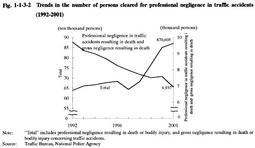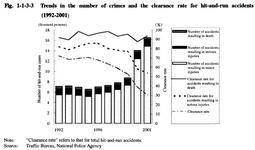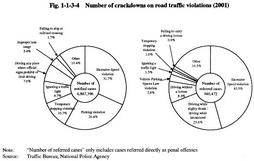| Previous Next Index Image Index Year Selection | |
|
|
1 Trends in traffic offenses (1) Professional negligence in traffic accidents Fig. 1-1-3-1 shows the trends in the number of traffic accidents, persons killed or injured in traffic accidents since 1946. The number of persons killed in traffic accidents has been decreasing since 1993. On the other hand, the number of traffic accidents has been increasing since 1978, setting an all-time high in 1993. Since then, it has continued to hit new highs every year. Moreover, the number of persons injured in traffic accidents has also been rising along with the increase in traffic accidents, hitting record numbers in 1998. Since then, in the past few years, it has hit new record highs (see Appendix 1-5 ).
Fig. 1-1-3-2 shows the trends in the number of persons cleared for professional negligence in traffic accidents over the last decade. Along with the increase in traffic accidents, the number of persons cleared for professional negligence in traffic accidents has also increased, and in 2000, it exceeded 800,000 for the first time in the postwar period. In 2001, it has also increased by 2.4% from the previous year to 870,605. Although the number of persons cleared has been gradually increasing for professional negligence resulting in bodily injury, it has been gradually decreasing for professional negligence resulting in death and gross negligence resulting in death. Fig. 1-1-3-1 Trends in the number of traffic accidents, persons killed or injured in traffic accidents (1946-2001) Fig. 1-1-3-2 Trends in the number of persons cleared for professional negligence in traffic accidents (1992-2001) Fig. 1-1-3-3 shows the trends in the number of crimes and clearance rates for, what is termed, hit-and-run accidents (the intentional failure to declare accidents concerning professional negligence in traffic accidents, etc.). The number of crimes has increased since 1996 and rose noticeably in the last 2 years. Clearance rates, however, have been decreasing since 1996. In 2001, the clearance rate for total hit-and-run accidents fell to 30.3%, and that for hit-and-run accidents resulting in severe bodily injury remained at 53.7%. However, the clearance rate for accidents resulting in death increased by 6 percent from the previous year to 93.4%.Fig. 1-1-3-3 Trends in the number of crimes and the clearance rate for hit-and-run accidents (1992-2001) (2) Violation of traffic-related law In 2001, the total number of crackdowns on road traffic violations was 7,807,868, decreasing almost every year after peaking at 13,846,532 in 1984. Fig. 1-1-3-4 shows the number of crackdowns on road traffic violations in 2001. The number of notified cases of non-penal offenses under the traffic violation notification system was 6,867,396 (88.0% of the total number of crackdowns on road traffic violations). By violation type, the number of excessive speed violations was greatest, followed by stopping-parking violations, and temporary stopping violations. On the other hand, by violation type, as for the number of referred cases for violation of the Road Traffic Law as penal offenses, excessive speed violations was greatest, followed by driving while slightly drunk/intoxicated, and driving without a license. The so-called 3 major violations-drunken driving (driving while slightly drunk/intoxicated), driving without a license, and excessive speed violations-accounted for 77.4% of the total number of referred cases for penal offenses related to violation of the Road Traffic Law.
Fig. 1-1-3-4 Number of crackdowns on road traffic violations (2001) (3) New establishment of the offense concerning dangerous driving resulting in death or bodily injury The offense concerning dangerous driving resulting in death or bodily injury was newly established (and came into force in December, 2001) under Partial Amendment of the Penal Code (Law No.138, 2001) which had been established on November 28, 2001. Traditionally, persons who committed traffic accidents have been charged with violation of the Road Traffic Law and professional negligence resulting in death or bodily injury, which is a penal code offense. Regarding recent traffic accidents, however, there are many cases in which offenders killed or injured people by committing dangerous and heinous driving defying traffic laws, such as drunken driving and excessive speed violations. The offense concerning dangerous driving resulting in death or bodily injury aims at punishing these heinous acts as offenses corresponding to bodily injury by assault or bodily injury resulting in death. In 2001, though there was no one prosecuted for the above offense, we should be cautious about future trends of whether the number of traffic accidents will be reduced by the establishment of this new offense.
|



